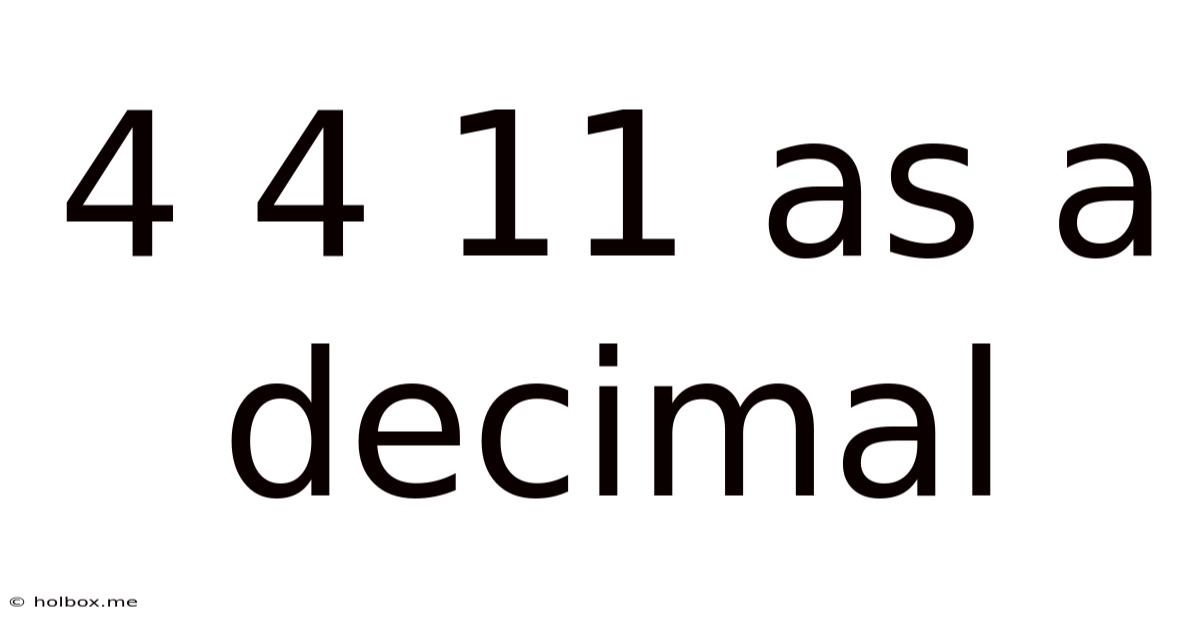4 4 11 As A Decimal
Holbox
May 09, 2025 · 4 min read

Table of Contents
- 4 4 11 As A Decimal
- Table of Contents
- Decoding 4 4 11: A Deep Dive into Decimal Representation
- Understanding Number Systems: Beyond Base 10
- Potential Interpretations of "4 4 11"
- Focusing on the Most Probable Interpretation: Concatenation
- Further Exploration: Handling Ambiguity in Numerical Expressions
- Conclusion: The Decimal Value of "4 4 11"
- Latest Posts
- Related Post
Decoding 4 4 11: A Deep Dive into Decimal Representation
The seemingly simple expression "4 4 11" immediately sparks curiosity. Is it a code? A mathematical puzzle? The answer lies in understanding how different numerical systems interact, specifically focusing on the conversion from a non-standard notation to the familiar decimal system. This article will unravel the mystery of "4 4 11," exploring its potential interpretations and demonstrating the core principles of base conversion. We'll delve into the possibilities, address potential ambiguities, and provide a robust understanding of the underlying mathematical concepts.
Understanding Number Systems: Beyond Base 10
Before tackling "4 4 11," we need to understand that our everyday number system, the decimal system, is just one of many. The decimal system, or base-10, uses ten digits (0-9) to represent numbers. Each position in a number represents a power of 10. For example, the number 1234 is:
- (1 x 10<sup>3</sup>) + (2 x 10<sup>2</sup>) + (3 x 10<sup>1</sup>) + (4 x 10<sup>0</sup>)
Other number systems exist, using different bases. Common examples include:
- Binary (Base-2): Uses only two digits (0 and 1). Crucial in computer science.
- Octal (Base-8): Uses eight digits (0-7).
- Hexadecimal (Base-16): Uses sixteen digits (0-9 and A-F). Also frequently used in computing.
The "4 4 11" notation doesn't directly align with any of these standard bases. This suggests we need to explore less conventional interpretations.
Potential Interpretations of "4 4 11"
The lack of explicit separators or base indicators in "4 4 11" leaves room for multiple interpretations. Let's examine some possibilities:
1. Concatenation of Base-10 Numbers:
The simplest interpretation treats "4 4 11" as a concatenation of three base-10 numbers: 4, 4, and 11. This would lead to a result obtained by simply placing these numbers side by side, resulting in the number 4411 in decimal form. This is arguably the most straightforward understanding of the given expression.
2. Representation in a Non-Standard Base:
It's possible "4 4 11" represents a number in a non-standard base. However, the repeated "4" suggests a potential pattern or structure, and the number 11 hints at the possibility that this might be a mixed-radix system.
In such systems, each position may have a different base. The use of the number 11 may indicate a larger base than 10. We need to find three different bases such that 4, 4, and 11 make a meaningful representation. This interpretation leads to potentially multiple calculations, depending on our selection of bases for each digit. We may encounter issues like the fact that the digits used exceed the base, making such an interpretation quite challenging. This approach lacks a clear pattern and is less likely given the simple appearance of the expression.
3. Encoded Message or Puzzle:
Beyond numerical interpretations, "4 4 11" could represent an encoded message or a piece of a larger puzzle. Without further context or information, this possibility remains speculative. It might involve a substitution cipher, where each number represents a letter or symbol, or part of a larger code requiring a specific key to decode. The lack of context makes this a less likely primary interpretation.
4. A Sequence or Pattern:
The expression might represent a sequence or a part of a mathematical pattern. To confirm this, we'd need more information. For instance, it could be the beginning of an infinite series, a finite sequence with a specific rule, or part of a larger series of such number expressions. However, without any subsequent numbers or associated information, this remains largely speculative.
Focusing on the Most Probable Interpretation: Concatenation
Given the ambiguity, the most straightforward and likely interpretation is the concatenation of base-10 numbers. This yields the decimal number 4411. This approach relies on the absence of any explicit indication of a different base or any additional context suggesting a more complex representation.
Further Exploration: Handling Ambiguity in Numerical Expressions
The example of "4 4 11" highlights a crucial aspect of mathematical notation: the importance of clarity and unambiguous representation. When encountering such expressions, always consider the following:
- Context: The surrounding information can significantly impact interpretation.
- Notation: The presence or absence of separators, base indicators, or symbols provides clues.
- Common Practices: Favor the simplest interpretation unless there's compelling evidence otherwise.
- Assumptions: Be clear about any assumptions made when interpreting ambiguous expressions.
In many programming languages, the lack of separators would lead to such concatenation directly. Understanding the context in which such an expression was given is vital for making informed interpretations.
Conclusion: The Decimal Value of "4 4 11"
While multiple interpretations exist, the most probable, and arguably the most sensible, approach is to interpret "4 4 11" as a concatenation of base-10 numbers. This yields the final answer: 4411 in decimal notation. This conclusion arises from a balance of simplicity, lack of further contextual information, and common practice in handling similar numerical expressions. The example serves as a valuable reminder of the need for clear notation and the consideration of context when interpreting potentially ambiguous mathematical expressions. Further investigation would require additional information or clarifying details to explore alternative representations.
Latest Posts
Related Post
Thank you for visiting our website which covers about 4 4 11 As A Decimal . We hope the information provided has been useful to you. Feel free to contact us if you have any questions or need further assistance. See you next time and don't miss to bookmark.